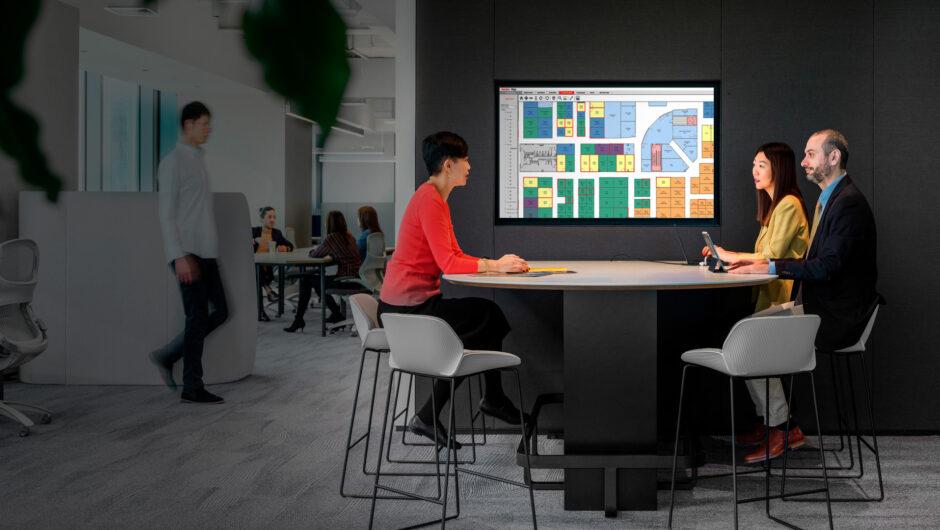Editor’s Note: In a past occupation, Samantha managed an organization’s space management system as an administrative and end user.
As organizations continue to define the evolving modern workplace, facility managers, real estate executives, and space management system users are reinvigorating the demands of the hybrid office on their everyday duties. The most prevalent area for businesses today is monitoring and tracking their physical space in relation to the demand for space. The core of space management is centered on maintaining an inventory that accounts for square footage, types of spaces available, and how many individuals need to occupy the space.
As the hybrid office has continued to change over the past years, space management for the workplace is more important than ever for businesses, real estate professionals, and employees. As many organizations are wrestling with people returning to the office and the associated challenges, including headcount growth, headcount turnover, and new ways of working. Having a single source of data for space inventory within an organization is a necessity to continue to move organizations forward.
With hybrid work creating new demands for organizations and employees alike, space management systems, like Wisp by Gensler, are needed now more than ever to increase workplace flexibility, to modify and adjust with employees’ schedules, and to pivot quickly with continued changing habits. Understanding what an average day entails for those responsible for managing a space management system elevates the importance of this role and highlights how the information can quickly assist businesses to meet changing demands.
Get Wisp to Meet Your New Workplace Demands
Here’s a look at what my typical day looks like as a Space Management Systems user in the new, modern workplace:

A “Typical” Morning at the Office
While I normally sit in Boulder, today I’m traveling to our office to collaborate with the building’s facilities specialist on an upcoming project. Our team’s working patterns have changed considerably since the pandemic, and we’ve decided to complete a time utilization and observation study to further understand how (and where) our people are working.
I start my day as an end-user by logging into Gensler’s desk reservation system and booking a workstation near my colleague. Then, I’ll pivot to my system admin role to set up and manage the study. Over the next two weeks, we’ll walk our space every hour to observe and collect data on how people are using the office space with the Gensler Observe app. Then, we’ll share the normalized data with our workplace strategists who will synthesize, identify work patterns, assess the space utilization, and correlate it to the business goals with proposed changes to improve the overall utilization of the workplace.
One of my key responsibilities is performing quarterly space reviews, and while walking around the third floor of the building I notice a few employees were assigned to the wrong workstations. I also notice a few furniture changes, so I log into our space management system, Wisp by Gensler, download the floorplan to my tablet, quickly sketch the new layout, and submit all the necessary updates through the Wisp site. This informs my space management partner of the changes, who will then update the floor plans in the system to reflect the physical layouts. Having an accurate system of record keeps our facilities team organized as we navigate day-to-day requests while also providing the data needed for strategic facilities planning through the space management system.
Then, I head to a meeting with the Director of Marketing to learn more about goals in the upcoming year, which includes hiring 15 additional employees. Pre-pandemic, the office was occupied at 95% capacity with a 1:1 desk ratio. Now, the team is working hybrid. Employees who are in the office over three days a week will be assigned a dedicated space and those only working two to three days in the office will be free address and assigned to a neighborhood, which requires those workers to make a desk reservation each day they come in. During this meeting, we create floor plan scenarios in our space management system to redefine the Marketing department neighborhood and identify reservable and dedicated spaces within it. We utilize floor plan scenarios to hypothetically plan moves of all sizes. This allows us to first create departmental adjacencies and then work with the department leads to determine who will sit where without adjusting our physical space.
After redefining the space for the Marketing team, the executive team pursues assessing the carbon footprint of the facilities we lease and own. I generate reports for square footage, occupancy, space types, and desk reservation reports for the team. These reports provide data-informed answers to the team’s specific needs and this data also facilitates the creation of an informed strategy for the organization as a whole. Together, we continue to strategize how we can reach our company’s carbon neutrality goal of 2030. In order to take responsibility for our impact, we need accurate data to understand what our baseline carbon footprint impact is and how we can improve it.

Pivoting My Afternoon for More Space Management Demands
After a morning filled with multiple meetings, I catch up on my emails and see I received a notification for a move request. An employee wants to move to a different workspace to improve collaboration as they work on a new project. Our team requests a five-day notice to ensure we can execute a seamless move. According to their occupant record in our space management system, this employee has additional ergonomic needs, which leads me to follow up with questions on specifics. After my facilities team confirms they can complete the request within the timeframe I approve the individual’s request to move workstations.
Prior to implementing our space management system, we were managing moves via email and scratching names on a printed floor plan and the ergonomic equipment was managed in a separate spreadsheet. Now, we’ve streamlined our process and created transparency for our entire organization by giving all employees access to accurate workplace floor plans to help them find colleagues, locate spaces such as conference rooms, and identify where life safety equipment is stored.
Our space management solution is also integrated with our HRIS (Human Resources Information System) and every day at 3 p.m. I have a reminder on my calendar to check for new hires and terminations. I assign any new employees workspaces and also remove any departed employees from our system to maintain accuracy. This integration saves our team from manually entering and updating occupant records and ensures data integrity.
Rounding out my day, I meet with a supplier to source more environmentally-friendly cleaning supplies. As we work towards our carbon neutrality goal, it is crucial to use products that are healthy for the environment and keep our employees safe. I log into our space management system and download PDFs of our floor plans for the entire portfolio. The floor plans include square footage and space types so our vendor can calculate the amount of supplies we need to keep our facilities safe and clean.

End of the Day in the New Hybrid Ecosystem
At the end of the workday, I pack up my computer and check out of my desk through our app. After employees leave the office, our custodial team logs into our space management system to review what desks had reservations for the day so they can identify which workstations need to be cleaned. As a result, since implementing desk reservations, our staff has reduced the amount of time and supplies used to keep our facilities clean and safe while maintaining the highest standards.
Our space management system assists our workers in navigating the changing workplace, improves efficiency for our facilities teams, and informs our strategic planning as an organization. The space management solution also helps keep our workplace agile through the evolving hybrid ecosystem and ensures spatial planning decisions are backed with data. Utilizing a single source of record has proven to be critical to the success of our workplace’s day-to-day operations, strategic planning, and the future of work as whole.


